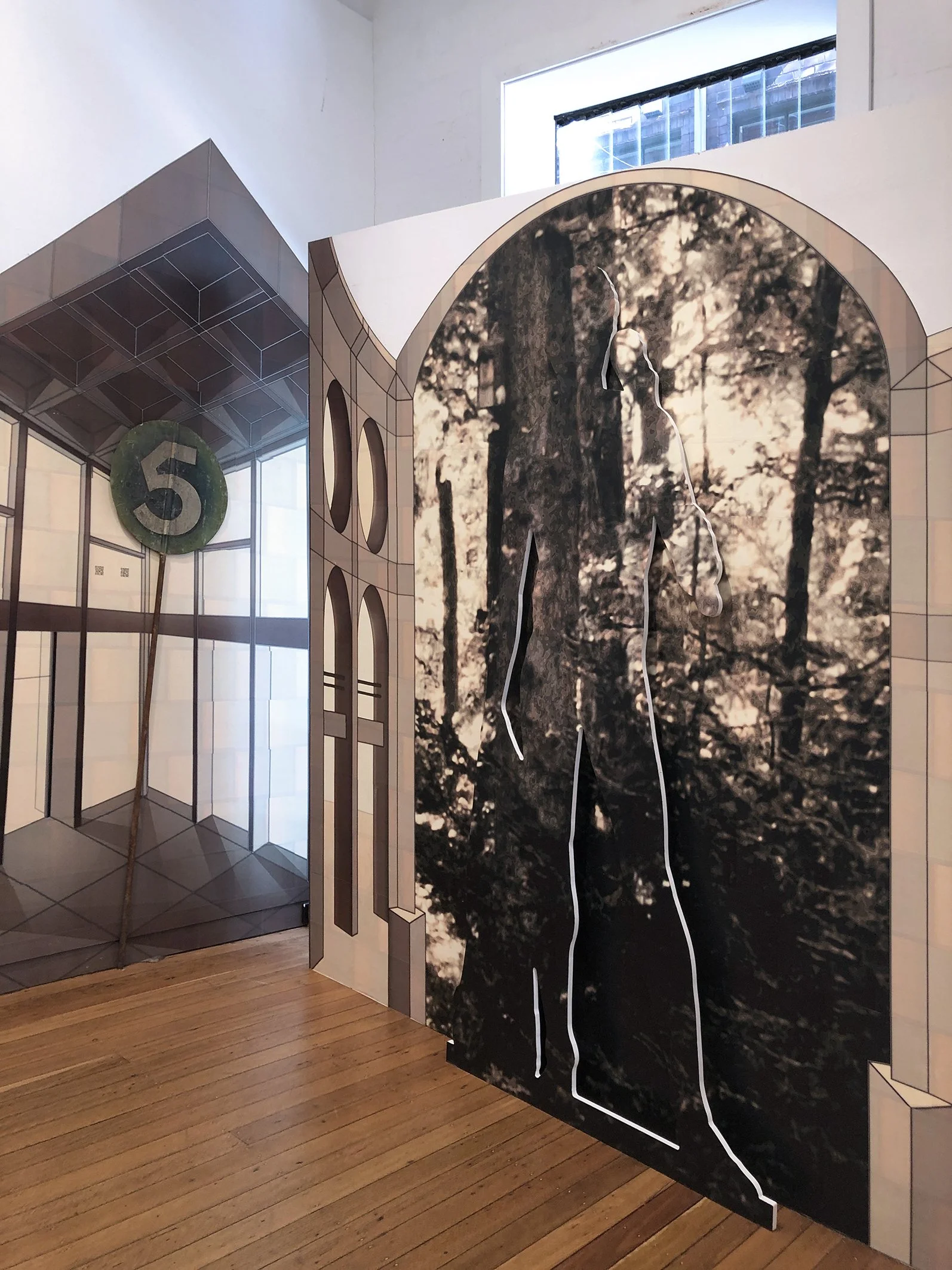
Savour Labour: The Brick Veneer Belvedere
2021, Cross Art Projects, Sydney.
2,557 overlapping 80 gsm monochromatic A4 photocopies (Laser Prints) on recycled A4 paper applied onto wall. Various artefacts from the Trades Hall Sydney. Soundscape by composer Louise Loh.
Savour Labour (The Brick Veneer Belvedere) 2021 was an immersive, multi-perspectival, spatial environment confabulated out of 2,557 overlapping 80 gsm monochromatic A4 photocopies (Laser Prints) on recycled paper. It was installed at Cross Arts Projects during April 2021 opening purposefully on May Day. It was on show until June 5, 2021. Savour Labour was developed in a dialogue with Sydney Trades Hall and Unions NSW focusing on the ephemera generated within the Labour Movement by individuals, principally volunteers who produced material for the 8 Hour Day marches and parades that were a regular feature of Australian cities and towns beginning in 1856 and continuing until the early 1970’s.
Unions NSW holds a nationally consequent collection of artefacts associated with their (ongoing) struggle better conditions for working people. In Sydney many of these including the sumptuous and celebrated banners produced by professional artists during the 19th and early 20th centuries are displayed in the 1888 heritage listed Sydney Trades Hall at 4-10 Goulburn Street. These have and continue to be the subject of many curated exhibitions and have been included in museum and gallery projects since the 1970’s. Savour Labour focused on the more modest and underexplored artefacts produced by non-professionals, anecdotally the family members of Unionist’s and used primarily as parade muster markers and as decorations worn by the horses who pulled the parade floats prior to the use of cars and trucks for this purpose.
To develop Savour Labour, we met regularly with Neale Towart and Bill Pirie volunteer archivists overseeing the Unions NSW collections. As the project developed, we selected various objects, discussing with Neale and Bill their provenance and other matters relating to their Object Biographies. We then reached out to Bundjalung, Kulilli and South Sea Islander man, sound artist and journalist Daniel Browning to contribute a suite of corresponding Subject biographies. Both the Object and Subject biographies were able to be accessed through QR codes within or appendaged to the cartouches that the selected artefacts were displayed within.
The secondary title – Brick Veneer Belvedere from the Italian for “beautiful view”, extends our exploration into building typologies particularly those with a close relationship to the garden. The garden we choose to explore in the context of savouring labouring was Berlin’s Teirgarten, focusing on vista’s visible from the spot where Rosa Luxemburg and Karl Liebknecht were executed by right wing para-militarists in 1919.
We adapted our customary A4 grid based on parallel horizontal and vertical bands that closely resemble “Stack bond” brickwork into a staggered pattern resembling “Stretcher bond”, the most common bricklaying pattern in use. We then reached out to Favetti, a Sydney family business whose traditional bricklaying skill brought them international attention when their founder Peter Favetti came out of retirement to oversee the complex pattern of angle laid bricks for Frank Gehry’s Dr. Chau Chank Wing Building at the University of Technology, Sydney. The team at Favetti agreed to create a second Belvedere within our existing installation grid by designing a new façade. This was printed on differently coloured paper and applied over the top of our Brick Veneer Belvedere, visible but concurrently obscure. A ghost of something lost returned.
Savour Labour was accompanied by a soundscape from composer Louise Loh.
Savour Labour (The Brick Veneer Belvedere) overview from left hand side. Objects from the left: Parade Assembly Point Marker 8 (Hand painted metal and wooden pole) Bricklayers Hob - a three-sided box carrying bricks and other building materials. It is borne on a long handle and carried over the shoulder. Repeated use caused deformities and limited the active working life of labourers, it was banned in New South Wales in the late in 1960’s, Horse Collar (fabric and upholstery paraphernalia over wicker and wire frame), RUBBER WORKERS Banner (synthetic fabric, gold letters and trimming, painted wooden drapery rod and finials)
Savour Labour (The Brick Veneer Belvedere) view of left-hand corner of the Brick Veneer Belvedere. From the left: Jardiniere (Laser cut urn shaped void covered back and front with Black and White 80gsm A4 photocopy) Brickies Hob, Belt Buckles (a contemporary interpretation of a miner’s traditional custom of having the first sample of ore they extract fashioned into a decorative object. These are made from bronze dipped iron), Parade Assembly Point Marker 69 (Hand painted metal) TUCKPOINTERS Banner (synthetic fabric, gold letters and trimming, painted wooden drapery rod and finials).
Section of the Alpha Numerical installation grid showing our adaptation of the Stretcher Bond Brick laying pattern. This shows the cartouches framing artefacts described in the preceeding image.
Savour Labour (The Brick Veneer Belvedere) Section of the back wall. Parade Assembly Point Marker 8 (Hand painted metal and wooden pole)
Savour Labour Street view. Window box, 80 gsm A4 photocopy (laser print), Jardiniere (Laser cut urn shape covered back and front with Black and White 80gsm A4 photocopy on pink paper)
Savour Labour section of left-hand wall. From left Laminated, Type “C” photograph applied to laser cut polygonal 4 mm Dibond panel, Inverted Horse Head Half-Tiara (fabric and upholstery paraphernalia over wicker and wire frame).
The Farnese Heracles. Laser cut 2 cm MDF covered with Black and White photocopy on 80 gsm A4 paper. The classical civilisation of the West’s foremost image of relaxation post work. The Farnese Heracles shows Heracles leaning on his club, which has the skin of the Nemean lion draped over it, resting after completing his first Labour.
Savour Labour view of right-hand corner, from left Parade Assembly Point Marker 5 (Hand painted metal and wooden pole) and the Farnese Heracles.
Jardiniere (Laser cut urn shaped void covered back and front with Black and White 80gsm A4 photocopy)








